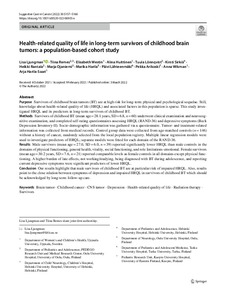Health-related quality of life in long-term survivors of childhood brain tumors: a population-based cohort study
Remes Tiina; Ljungman Lisa; Harila Marika; Wikman Anna; Lönnqvist Tuula; Harila-Saari Arja; Arikoski Pekka; Rantala Heikki; Ojaniemi Marja; Huittinen Alina; Lähteenmäki Päivi; Westin Elisabeth; Sirkiä Kirsti
https://urn.fi/URN:NBN:fi-fe2022081153841
Tiivistelmä
Purpose
Survivors of childhood brain tumors (BT) are at high risk for long-term physical and psychological sequelae. Still, knowledge about health-related quality of life (HRQL) and associated factors in this population is sparse. This study investigated HRQL and its predictors in long-term survivors of childhood BT.
Methods
Survivors of childhood BT (mean age = 28.1 years, SD = 6.8, n = 60) underwent clinical examination and neurocognitive examination, and completed self-rating questionnaires assessing HRQL (RAND-36) and depressive symptoms (Beck Depression Inventory-II). Socio-demographic information was gathered via a questionnaire. Tumor- and treatment-related information was collected from medical records. Control group data were collected from age-matched controls (n = 146) without a history of cancer, randomly selected from the local population registry. Multiple linear regression models were used to investigate predictors of HRQL; separate models were fitted for each domain of the RAND-36.
Results
Male survivors (mean age = 27.0, SD = 6.0, n = 39) reported significantly lower HRQL than male controls in the domains of physical functioning, general health, vitality, social functioning, and role limitations-emotional. Female survivors (mean age = 30.2 years, SD = 7.6, n = 21) reported comparable levels as female controls in all domains except physical functioning. A higher burden of late effects, not working/studying, being diagnosed with BT during adolescence, and reporting current depressive symptoms were significant predictors of lower HRQL.
Conclusion
Our results highlight that male survivors of childhood BT are at particular risk of impaired HRQL. Also, results point to the close relation between symptoms of depression and impaired HRQL in survivors of childhood BT which should be acknowledged by long-term follow-up care.
Kokoelmat
- Rinnakkaistallenteet [19207]
